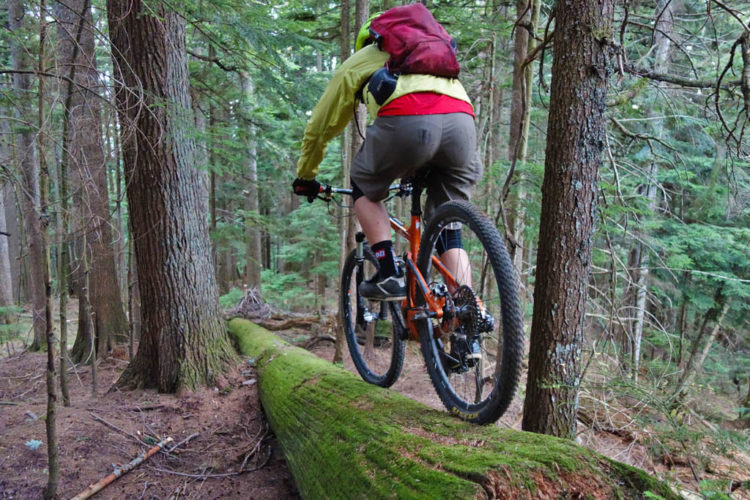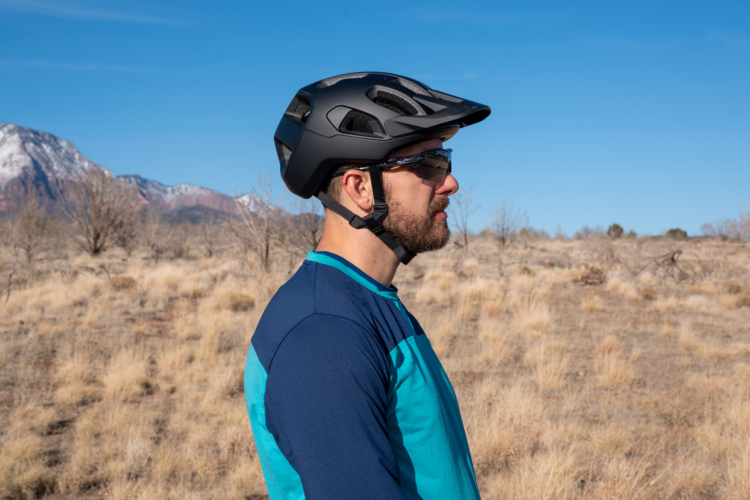
As temperatures start to rise, many mountain bikers–myself included–are dealing with a sore point: muscle cramps. While muscle cramps are fairly common and mostly benign, they can be painful and annoying to deal with during a mountain bike ride. This article will briefly discuss common causes of leg cramps, and will offer tips for preventing and dealing with cramps brought on by mountain biking.
The information in this article has been collected from various sources, including tips from our readers, MedicineNet.com, and Mayoclinic.org.
What causes leg cramps?
Most of the cramps experienced by mountain bikers are known as “true” cramps and can be tied to one or more of the following conditions.
Muscle fatigue: Mountain biking is a strenuous activity, and riders often push themselves to the limit–and beyond. Long days and big climbs can make cramps more likely, as can a lack of strength conditioning.
Dehydration: Excessive sweating or a failure to hydrate before a mountain bike ride can lead to cramping on the trail.
Low mineral levels: This is tied to dehydration and sweating, as certain minerals like sodium are depleted during a ride. In addition to sodium, it is also thought that low levels of calcium, magnesium, and/or potassium can lead to cramping as well. Low potassium is a particular muscle cramp trigger for those with weak muscles. Some claim vitamin deficiencies may be to blame for muscle cramps, especially low levels of vitamins B1, B5, and B6.
Beyond the causes of “true” cramps, there are a couple other risk factors for developing muscle cramps.
Age: Older individuals are generally more susceptible to muscle cramps.
Repetitive motion: Dystonic cramps are caused by overuse (for example, writer’s cramp) and mountain bikers can experience these types of cramps due to poor bike set-up or extremely long days in the saddle.
For me personally, I usually get the worst leg cramps when more than one of the conditions above are met. On rides when I’ve experienced multiple leg cramps, it’s usually been hot, I haven’t been drinking and/or eating enough, I’ve been in the saddle for hours, and I’m doing a lot of climbing.
How to prevent leg cramps?
There are a number of preventative measures mountain bikers can take to prevent leg muscle cramps.
Hydrate: Ensuring adequate hydration is a pretty simple way to avoid leg cramps. Be sure to hydrate before, during, and after the ride to keep body fluid levels in check. However, water alone generally isn’t enough. A simple electrolyte solution containing sodium and other minerals like potassium and magnesium is generally a good idea. However, it’s also possible to get the necessary minerals from food and even electrolyte pills if necessary.
Get your minerals: Drinking electrolytes during the ride won’t do much good if a rider is starting out at a vitamin or mineral deficit before the ride even begins. A good multi-vitamin and/or a balanced diet should provide the necessary vitamins and minerals. For those who are susceptible to leg cramps, keep an eye on sodium, calcium, magnesium, and potassium intake. For riders with low calcium levels, the real culprit may be a lack of vitamin D, which helps the body absorb calcium.
Avoid hot weather: If possible, ride early in the morning or at night during the summer. Try acclimating yourself to riding in the heat by taking things slowly and gradually building up during the season.
Get strong: Like acclimating to the heat, it’s also important to prepare muscles for difficult rides. For those who experience cramps due to fatigue, consider working up to longer or more difficult rides through conditioning and strength training.
Warm up: Diving right into a big climb with cold muscles is never a good idea. Warm up before the ride by taking a few laps around the trailhead or do like the pro racers do, and set up a trainer in the parking lot.
Stretch: Many mountain bikers neglect stretching and flexibility exercises, much to our detriment. Loose muscles are less likely to cramp, so swallow your pride and get into a stretch routine at the trailhead before heading out! That said, stretching cold muscles can cause other issues–it’s best to stretch after you’ve completed your warm up.
Use your gears: This tip is related to getting strong and avoiding fatigue. I’ve personally found that when I choose an easier gear for climbing instead of mashing a big gear, I can get more cramp-free miles out of my leg muscles.
How to deal with leg cramping?
One study says that 95% of adults will experience muscle cramps at least once during their lifetime, so getting cramps isn’t a question of if, it’s a question of when. If you do experience muscle cramps on the trail, there are some things you can do to recover your ride.
Drink fluids: Cramps caused by dehydration are pretty easy to solve: just add water. Hydrating won’t make cramps disappear immediately, but will help in the long run.
Get minerals: Many riders, including several of our readers, recommend downing a dose of salt by way of a mustard packet or pickle juice. I’ve had good results with Hammer electrolyte pills, which serve a similar purpose without the gag-inducing taste.
Some swear by bananas for eliminating in-ride cramps, and if low potassium is the culprit, bananas are a good choice. For me personally, bananas are slow to work, if they work at all.
Stretching: This is probably my go-to move whenever I get a leg cramp. It may take a moment before getting comfortable enough to stretch the muscle, but once the cramp subsides a bit, stretching will typically bring relief. At least, until the muscle cramps up again. See tips above.
Massage: Similar to stretching, massaging a cramped muscle can offer relief. Massaging the muscle is a bit more time consuming and/or painful than stretching, but for many it is a good solution.
Warm water: Most of us won’t have access to warm water during a ride when a leg cramp strikes, so save this tip for home. Cramped muscles can remain sore well after the ride is over, and warm water will help relieve some of the tension and strain.
For many riders, leg cramps are a part of life, though fortunately they don’t have to end the ride prematurely. Just take steps to avoid leg cramps and be prepared to act once they strike.
Your turn: Share and get more tips for dealing with leg cramps on our forums.
























18 Comments
May 25, 2017
And now, even stretching has been found to have little value (though some studies suggest if you are a stretcher already, you should continue to stretch before activity): https://player.fm/series/slates-the-gist/stretching-the-truth-with-maria-konnikova
Next thing I'll learn is that purchase of a carbon bike won't make me automatically faster!
May 25, 2017
May 25, 2017
May 25, 2017
May 29, 2017
I personally don't have issues with cramps (mostly). Sometimes on very long, hot events, like the Berryman Trail Epic or Syllamo's Revenge, I'll start getting the nagging sensation of cramps but never really the full on deal except maybe once or twice.
I dismiss most of the things people do (pickle juice for example) but a couple of years ago I was racing the Dirty Kanza and at mile 80, after some heavy walking and then deep digs to ride through mile after mile of sticky clay, my legs started to cramp some at the smallest provocation. Enter my friend, Brett, who produced a small bottle filled with real pickle juice (not the pre-made packaged stuff). Two swigs and 20 minutes later my legs were back to full strength. It tasted really good, too. I mean, who doesn't like salt?
The upside of this in addition to stopping cramps is that it didn't bother my stomach at all. I've tried a few things over the years and they all really fry my stomach, which has a tendency to get very fussy during big days.
Now if I'm doing big efforts with lots of heat/humidity, I'll come home and take a big draw off the dill pickle jar in the fridge. Seems to speed recovery some.
Jul 2, 2019
Jun 30, 2019
I was a super cramper. Meaning, I did all the supposed things right (much of which is mentioned in this article) and still cramped. Numerous electrolyte pills helped (along with copious amounts of water and good food) but never stopped the cramping. Now I have not cramped in over 3 years by using Osmo Nutrition pre-load and active hydration. The products simply work better than anything I have tried, and I've tried a lot of the main ones out there.
What I learned through the process of discovering Osmo, is that a lot of the liquid products out there with maltodextrin and other heavy carb drinks actually dehydrate you. Heavy amounts of liquid carbs hitting the gut forces the gut to pull water from the rest of the body and therefore starting a dehydrating process that no amount of electrolyte pills can make up for.
The key with Osmo (that is backed by science) is that hydration needs to be at or less than the osmolality of the blood plasma for the body to properly hydrate. If the liquid is at or below the osmolality of the blood, then it absorbs much quicker. In the case of Osmo, it absorbs at 3x the rate of water.
I have come to realize that hydration is far more important in my performance than what I am eating (although I do stick to whole natural foods with Osmo as much as possible). I have also noticed that I need far fewer calories when I am active when I am properly hydrated.
I also believe, we are all a little different chemical makeup and have to find what works for oneself. I have definitely found what works for me and now many of my friends are finding the same products solve their cramping issues as well.
Cheers,
Chris
Jun 27, 2019
As a physician practicing 32 years, I was discussing this exact topic with a friend of mine who is a physician for a professional baseball team experiencing similar issues during the heat of summer with his players, bananas had a lethargic effect at best, amazingly, he was able to prevent the majority of cramps by encouraging his players to eat potato chips!!!! He related that potatoes have a higher potassium content than bananas and the sodium levels were more than enough.... I tried this on my last bike ride with good results(I am a 62-year-old MTB writer)
Jun 27, 2019
Hard pass on pickle juice for me.
Jul 6, 2021
Again great article with lots of good tips! Thanks
Jun 20, 2022
Jun 20, 2022
Jan 3, 2018
Jun 28, 2019
See article: https://www.healthline.com/health/pickle-juice-for-cramps
Jul 2, 2019
May 27, 2017
Jun 27, 2019
May 25, 2017